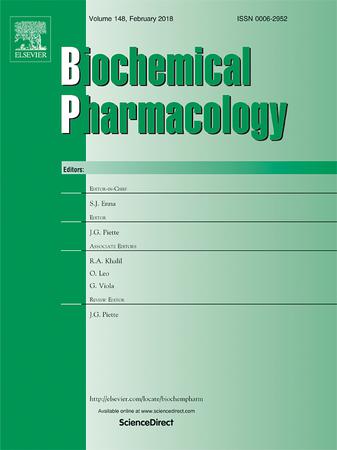在肝纤维化过程中,凝血素- l通过调节PI3K/AKT通路减轻肝星状细胞的活化和血管生成
IF 5.6
2区 医学
Q1 PHARMACOLOGY & PHARMACY
引用次数: 0
摘要
纤维化是慢性肝病的一种伤口愈合反应,是疾病进展过程中的潜在治疗靶点。肝星状细胞(hsc)的激活在肝纤维化中起着核心作用,并描述了纤维化进展过程中的表型变化。凝血素- l是一种来自薇兰属植物的薇兰内酯,具有多种生物活性,包括抗高血糖和抗血脂异常作用。然而,其治疗HSC活化、病理性血管生成和肝纤维化的疗效尚不清楚。本研究探讨了凝血素- l对HSC活化和病理性血管生成的影响,并通过蛋氨酸和胆碱缺乏(MCD)饮食诱导的C57BL/6小鼠肝纤维化模型在体内验证了这些发现。采用转化生长因子β (TGF-β)激活HSC细胞株LX-2体外实验研究凝血素- l的治疗效果。网络药理学用于靶标预测,其次是基于人脐静脉内皮细胞(HUVEC)细胞的血管生成测定。采用血清生化、组织病理学和免疫组织化学方法对MCD饮食致肝纤维化小鼠模型进行验证研究。我们发现,凝血素- l通过抑制PI3K/AKT信号通路,降低星状细胞中血管内皮生长因子(VEGF)的表达和分泌,从而减轻TGF-β诱导的星状细胞活化,并表现出抗血管生成作用。在MCD饮食性肝纤维化模型中,凝血素- l可减轻肝损伤,改善肝功能,减少胶原沉积。总之,我们的研究结果强调了凝血素- l在体外和体内肝纤维化模型中的抗纤维化和抗血管生成作用,从而表明其在慢性肝脏疾病(包括代谢功能障碍相关脂肪性肝炎(MASH))中的治疗潜力。本文章由计算机程序翻译,如有差异,请以英文原文为准。

Coagulin-L alleviates hepatic stellate cells activation and angiogenesis through modulation of the PI3K/AKT pathway during liver fibrosis
Fibrosis, a wound healing response in chronic liver diseases, is a potential therapeutic target during the disease progression. The activation of hepatic stellate cells (HSCs) plays a central role in liver fibrosis and depicts phenotypic change during fibrosis progression. Coagulin-L, a withanolide from Withania coagulans, has shown diverse biological activities, including anti-hyperglycemic and anti-dyslipidemic effects. However, its therapeutic efficacy against HSC activation, pathological angiogenesis and liver fibrosis is unknown.
This study investigates the effects of Coagulin-L on HSC activation, pathological angiogenesis and validates these findings in vivo using a methionine and choline-deficient (MCD) diet-induced liver fibrosis model in C57BL/6 mice.
Therapeutic efficacy of Coagulin-L was studied using transforming growth factor beta (TGF-β) activated HSC cell line LX-2 in vitro. Network pharmacology was used for target prediction, followed by Human umbilical vein endothelial cells (HUVEC) cell based angiogenic assays. The validation studies were carried out in a mice model of MCD diet induced liver fibrosis using serum biochemistry, histopathological assessment and immunohistochemistry methods.
We found that Coagulin-L mitigated TGF-β induced activation of stellate cells and exhibited anti-angiogenic effects by downregulation of vascular endothelial growth factor (VEGF) expression and secretion from stellate cells with inhibition of the PI3K/AKT signaling pathway. In the MCD diet-induced liver fibrosis model, Coagulin-L alleviated liver injury, improved liver function, and reduced collagen deposition.
Collectively, our results underscored the anti-fibrotic and anti-angiogenic effects of Coagulin-L in vitro and in vivo liver fibrosis models, thereby indicating its therapeutic potential in chronic liver diseases including metabolic dysfunctional-associated steatohepatitis (MASH).
求助全文
通过发布文献求助,成功后即可免费获取论文全文。
去求助
来源期刊

Biochemical pharmacology
医学-药学
CiteScore
10.30
自引率
1.70%
发文量
420
审稿时长
17 days
期刊介绍:
Biochemical Pharmacology publishes original research findings, Commentaries and review articles related to the elucidation of cellular and tissue function(s) at the biochemical and molecular levels, the modification of cellular phenotype(s) by genetic, transcriptional/translational or drug/compound-induced modifications, as well as the pharmacodynamics and pharmacokinetics of xenobiotics and drugs, the latter including both small molecules and biologics.
The journal''s target audience includes scientists engaged in the identification and study of the mechanisms of action of xenobiotics, biologics and drugs and in the drug discovery and development process.
All areas of cellular biology and cellular, tissue/organ and whole animal pharmacology fall within the scope of the journal. Drug classes covered include anti-infectives, anti-inflammatory agents, chemotherapeutics, cardiovascular, endocrinological, immunological, metabolic, neurological and psychiatric drugs, as well as research on drug metabolism and kinetics. While medicinal chemistry is a topic of complimentary interest, manuscripts in this area must contain sufficient biological data to characterize pharmacologically the compounds reported. Submissions describing work focused predominately on chemical synthesis and molecular modeling will not be considered for review.
While particular emphasis is placed on reporting the results of molecular and biochemical studies, research involving the use of tissue and animal models of human pathophysiology and toxicology is of interest to the extent that it helps define drug mechanisms of action, safety and efficacy.
 求助内容:
求助内容: 应助结果提醒方式:
应助结果提醒方式:


